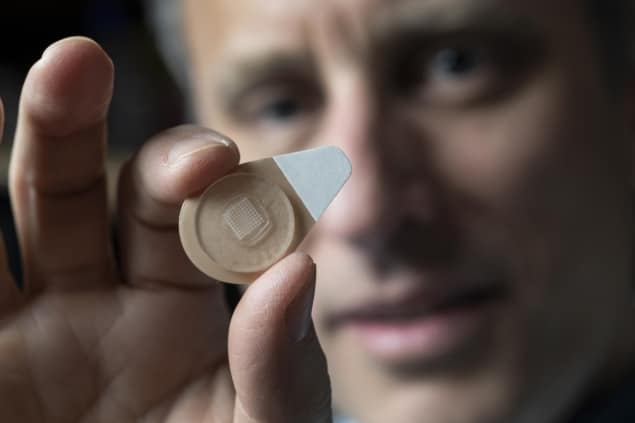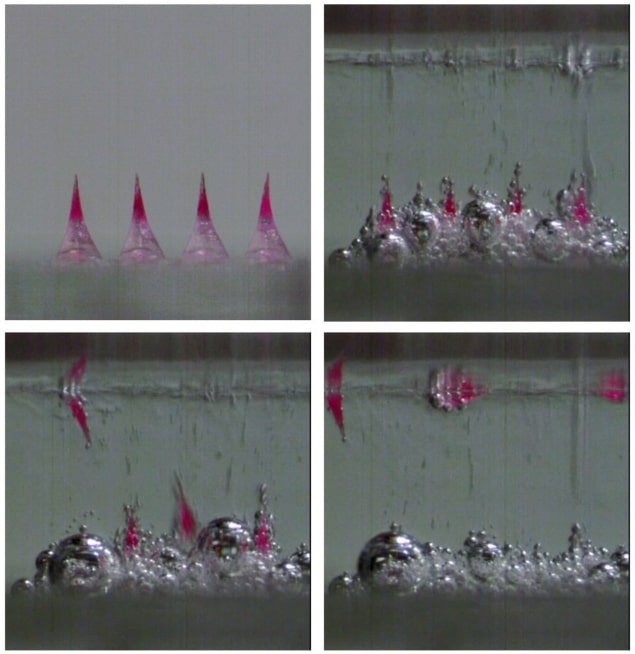
In an effort to increase access to long-acting contraception, a US-based research team has developed a microneedle patch that slowly releases contraceptive hormone for more than a month, and generates no biohazardous sharps waste (Science Advances 10.1126/sciadv.aaw8145).
According to team member Mark Prausnitz, from the School of Chemical and Biomolecular Engineering at Georgia Institute of Technology, there is a particular need for contraceptive methods that are both long-acting and capable of being self-administered. This is because most current long-acting contraceptives, for example subcutaneous implants and IUDs, must be administered by a healthcare worker. Meanwhile, most self-administered contraceptives, such as daily pills, need to be taken frequently.
“To enable women to achieve the convenience and reliability of a long-acting contraceptive that can be self-administered, we have developed a microneedle patch that can be painlessly administered to the skin and deposit microneedles below the skin surface to slowly release contraceptive hormone,” says Prausnitz.

The microneedles are made out of biodegradable polymer that encapsulates the contraceptive. To facilitate rapid separation of the microneedles from the patch backing, Prausnitz and his team – including colleagues at Georgia Tech plus scientists from the University of Michigan and the non-profit human development organization FHI 360 – incorporated effervescent material at the patch– microneedle interface. When the patch is applied to the skin, an effervescent chemical reaction occurs and weakens the interface between the microneedles and the patch backing.
“The final result is that a woman can press a patch to the skin, leave it in place for less than one minute, during which time effervescence is occurring, and then remove and discard the patch backing,” Prausnitz explains.
Microneedles deposited below the skin surface slowly biodegrade and release the contraceptive hormone levonorgestrel for approximately one month. “We did a series of in vitro experiments to develop the patch and confirmed its performance in vivo in a study using rats,” Prausnitz adds.
Towards human tests
In Prausnitz’s view, the key challenges in the study related to how best to formulate microneedles for slow release of the contraceptive and enable rapid separation of the needles from the patch backing. Slow-release systems using biodegradable polymer such as polylactic-co-glycolic acid are well known, but not in the form of microneedles, which adds additional constraints to the design.
“A notable issue for us was that, when we cast the solution to make the microneedles onto a silicone mould, there are complex transport processes taking place,” he says. “While we have a lot of experience making microneedles that dissolve quickly, and therefore involve casting with aqueous formulations, these microneedles required the use of organic solvents, which added new complexities.”
Other challenges included the fact that, upon casting onto the mould, the solvent can be absorbed into the mould and evaporate. The polymer and drug dissolved in the solvent can also precipitate.
“Solvent wetting of the mould surface matters, as does contact and adhesion of the precipitating polymer and drug to the mould surface. It is difficult to fully understand and control these transport phenomena carried out on the micron scale,” says Prausnitz.
Ultimately, the team overcame these issues by using a co-solvent system that minimizes solvent penetration into the mould and controls the rate of precipitation of the polymer and drug. To generate the effervescence required to separate the microneedles from the patch, the team incorporated sodium bicarbonate and citric acid into the patch backing. Contact with the skin’s interstitial fluid initiates a chemical reaction that generates carbon dioxide bubbles. This bubble formation mechanically weakens the interface between the microneedles and the patch.
While the researchers have not yet tested the patch’s contraceptive efficacy in humans, evaluation on 10 women showed that it was easily and painlessly applied.
“The next steps for us in this project are to make larger patches that contain more drug, suitable for giving human doses rather than the dose used in the current study for rats, and to prepare the patches with the quality control needed to be used in a human study,” adds Prausnitz. “We hope to carry out our first human study using these patches within the next two to three years.”



